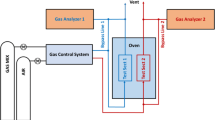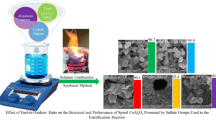Abstract
This study examines the catalytic performance of copper-alumina (CuAl) aerogel which is a possible alternative to the use of precious metals in automotive exhaust treatment systems which require simultaneous conversion of carbon monoxide, unburnt hydrocarbons and nitrogen oxides. To be a viable alternative, the aerogel materials need to withstand a slurrying process to enable coating onto a substrate and they need to maintain performance in a humid environment typical of what is seen in automotive exhaust. In this study, we slurried heat-treated copper-alumina aerogels in an acidic (pH ~4) aqueous solution under mechanical stirring. The solution was subsequently dried at 60 °C under ambient pressure conditions. Physical properties of slurried CuAl aerogel (surface area, X-ray diffraction, morphology) were similar to those of non-slurried materials. Catalytic testing in a simulated automotive exhaust environment demonstrated that the aerogels can survive exposure to humidity. The ability of the slurried and non-slurried aerogels to oxidize propene and carbon monoxide was similar under dry and humid conditions. In a high-O2 environment adding humidity degraded catalytic performance while in a low-O2 environment the humidity improved performance. The catalytic performance toward nitrogen monoxide was less consistent: the slurried sample did not perform as well as the non-slurried sample under any conditions.

Copper-alumina aerogels can be slurried and exposed to a humid exhaust stream and maintain three-way catalytic performance. The figures on the left show images of the material as prepared, and after heat treatment. Pore volume is reduced after heat treatment and slurrying. The images on the right show catalytic performance for CO in dry and humid conditions.
Highlights
-
Slurried copper-alumina aerogel largely maintains its physical structure.
-
Slurried copper-alumina aerogel shows three-way catalytic activity.
-
Copper-alumina aerogel is catalytically active in a humid simulated exhaust stream.
-
Light-off temperatures for copper-alumina aerogel are higher in humid exhaust.










Similar content being viewed by others
References
Maleki H, Hüsing N (2018) Current status, opportunities and challenges in catalytic and photocatalytic applications of aerogels: Environmental protection aspects. Appl Catal B Environ 221:530–555. https://doi.org/10.1016/J.APCATB.2017.08.012
Pajonk GM (1999) Some catalytic applications of aerogels for environmental purposes. Catal Today 52:3–13. https://doi.org/10.1016/S0920-5861(99)00057-7
Ingale SV, Wagh PB, Tripathi AK, Dudwadkar AS et al. (2011) Photo catalytic oxidation of TNT using TiO2-SiO2 nano-composite aerogel catalyst prepared using sol–gel process. J Sol-gel Sci Technol 58(3):682–688
Pierre AC, Pajonk GM (2002) Chemistry of aerogels and their applications. Chem Rev 11:4243–4266. https://doi.org/10.1021/CR0101306
Heywood JB (2018) Internal combustion engine fundamentals. McGraw-Hill Education, New York.
Bossi T, Gediga J (2017) The environmental profile of platinum group metals interpretation of the results of a cradle-to-gate life cycle assessment of the production of pgms and the benefits of their use in a selected application. Johns Matthey Technol Rev 61:111–121. https://doi.org/10.1595/205651317X694713
Heck RM, Farrauto RJ, Gulati ST (2009) Catalytic air pollution control: commercial technology, John Wiley & Sons, New Jersey.
Keysar S, Shter GE, de Hazan Y et al. (1997) Heat treatment of alumina aerogels. Chem Mater 9:2464–2467. https://doi.org/10.1021/CM970208S
Bouck RM, Anderson AM, Prasad C, et al. (2016) Cobalt-alumina sol gels: Effects of heat treatment on structure and catalytic ability. J Non Cryst Solids 453. https://doi.org/10.1016/j.jnoncrysol.2016.09.013
Juhl SJ, Dunn NJH, Carroll MK, et al. (2015) Epoxide-assisted alumina aerogels by rapid supercritical extraction. J Non Cryst Solids 426. https://doi.org/10.1016/j.jnoncrysol.2015.06.030
Gauthier BM, Bakrania SD, Anderson AM, Carroll MK (2004) A fast supercritical extraction technique for aerogel fabrication. J Non Cryst Solids 350. https://doi.org/10.1016/j.jnoncrysol.2004.06.044
Carroll MK, Anderson AM, Gorka CA (2014) Preparing silica aerogel monoliths via a rapid supercritical extraction method. J Vis Exp. https://doi.org/10.3791/51421
Anderson AM, Bruno BA, Donlon EA, et al. (2018) Fabrication and testing of catalytic aerogels prepared via rapid supercritical extraction. J Vis Exp. https://doi.org/10.3791/57075
Bono MS, Anderson AM, Carroll MK (2010) Alumina aerogels prepared via rapid supercritical extraction. J sol-gel Sci Technol 53(2):216–226
Tobin ZM, Posada LF, Bechu AM, et al. (2017) Preparation and characterization of copper-containing alumina and silica aerogels for catalytic applications. J Sol-Gel Sci Technol 84. https://doi.org/10.1007/s10971-017-4425-9
Anderson AM, Donlon EA, Forti AA, et al. (2017) Synthesis and characterization of copper-nanoparticle-containing silica aerogel prepared via rapid supercritical extraction for applications in three-way catalysis. In: MRS Advances
Posada LF, Carroll MK, Anderson AM, Bruno BA (2019) Inclusion of ceria in alumina- and silica-based aerogels for catalytic applications. J Supercrit Fluids 152. https://doi.org/10.1016/j.supflu.2019.05.004
Anderson AM, Bruno BA, Dilone F, et al. (2020) Effect of copper loading in copper-alumina aerogels on three-way catalytic performance. Emiss Control Sci Technol 6. https://doi.org/10.1007/s40825-020-00165-z
Nosrati RH, Berardi U (2018) Hygrothermal characteristics of aerogel-enhanced insulating materials under different humidity and temperature conditions. Energy Build 158:698–711. https://doi.org/10.1016/J.ENBUILD.2017.09.079
Armor JN, Carlson EJ (1985) A novel procedure for “pelletizing” aerogels. Appl Catal 19:327–337. https://doi.org/10.1016/S0166-9834(00)81755-8
Domínguez M, Taboada E, Molins E, Llorca J (2008) Co–SiO2 aerogel-coated catalytic walls for the generation of hydrogen. Catal Today 138:193–197. https://doi.org/10.1016/J.CATTOD.2008.05.027
Domínguez M, Taboada E, Molins E, Llorca J (2012) Co-Fe-Si aerogel catalytic honeycombs for low temperature ethanolsteam reforming Catal 2:386–399. https://doi.org/10.3390/CATAL2030386 Pages 386-399 2
Lee KJ, Choe YJ, Kim YH et al. (2018) Fabrication of silica aerogel composite blankets from an aqueous silica aerogel slurry. Ceram Int 44:2204–2208. https://doi.org/10.1016/J.CERAMINT.2017.10.176
Landau MV, Shter GE, Titelman L et al. (2006) Alumina foam coated with nanostructured chromia aerogel: efficient catalytic material for complete combustion of chlorinated VOC. Ind Eng Chem Res 45:7462–7469. https://doi.org/10.1021/IE0606744
Reichenauer G, Scherer GW (2001) Nitrogen sorption in aerogels. J Non Cryst Solids 285:167–174. https://doi.org/10.1016/S0022-3093(01)00449-5
Bruno BA, Anderson AM, Carroll M, et al. (2016) Benchtop scale testing of aerogel catalysts: preliminary results. SAE Tech Pap. https://doi.org/10.4271/2016-01-0920
Rappé KG, DiMaggio C, Pihl JA et al. (2019) After treatment protocolsfor catalyst characterization and performance evaluation: low-temperatureoxidation, storage, three-way, and NH 3 -SCR catalyst test protocols Emiss Control Sci Technol 52(5):183–214. https://doi.org/10.1007/S40825-019-00120-7
Schlatter JC (1978) Water-gas shift and steam reforming reactions over a rhodium three-way catalyst. SAE Tech Pap. https://doi.org/10.4271/780199
Sisk CN, Hope-Weeks LJ (2008) Copper (II) aerogels via 1, 2-epoxide gelation. J Mater Chem 18:2607–2610. https://doi.org/10.1039/B802174K
Gonçalves RV, Wojcieszak R, Wender H et al. (2015) Easy access to metallic copper nanoparticles with high activity and stability for CO oxidation. ACS Appl Mater Interfaces 7:7987–7994. https://doi.org/10.1021/ACSAMI.5B00129
Barbier J, Duprez D (1994) Steam effects in three-way catalysis. Appl Catal B Environ 4:105–140. https://doi.org/10.1016/0926-3373(94)80046-4
Acknowledgements
This material is based upon work supported by the National Science Foundation (NSF) under Grants No. IIP-1918217, IIP-1823899, DMR-1828144 and CBET-1228851. The funding source was not involved in conducting this research or preparing the manuscript. We thank Diana Lang for preliminary experimental work and Chris O’Brien for help with the UCAT testing. We are grateful to Rebecca Cortez and Yijing Stehle for discussions regarding interpretation of the AFM data.
Author Contributions
AMA: Conceptualization, Methodology, Investigation, Data Curation, Writing—Original Draft, Writing—Review & Editing, Supervision, Project administration, Funding acquisition BAB: Conceptualization, Methodology, Investigation, Data Curation, Writing—Original Draft, Writing—Review & Editing, Supervision, Project administration, Funding acquisition JS: Writing—Review & Editing, Investigation, Data Curation CA: Writing—Review & Editing, Investigation, Data Curation MKC: Conceptualization, Methodology, Investigation, Data Curation, Writing—Original Draft, Writing—Review & Editing, Supervision, Project administration, Funding acquisition.
Funding
This work was supported by National Science Foundation (NSF) Grants No. IIP-1918217, IIP-1823899, DMR-1828144 and CBET-1228851.
Author information
Authors and Affiliations
Corresponding author
Ethics declarations
Conflict of interest
The authors declare no competing interests.
Additional information
Publisher’s note Springer Nature remains neutral with regard to jurisdictional claims in published maps and institutional affiliations.
Rights and permissions
About this article
Cite this article
Anderson, A.M., Bruno, B.A., Santos, J. et al. Effect of slurry processing on the properties of catalytically active copper-alumina aerogel material for applications in three-way catalysis. J Sol-Gel Sci Technol 102, 422–436 (2022). https://doi.org/10.1007/s10971-022-05757-5
Received:
Accepted:
Published:
Issue Date:
DOI: https://doi.org/10.1007/s10971-022-05757-5




